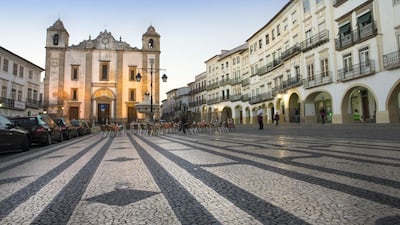Why Évora?
While much of Lisbon was flattened by the great earthquake of 1755, Évora – a former residence of the kings of Portugal and their royal court – survived more or less unscathed. As a result, this Unesco-listed city and capital of the Alentejo boasts an exceptionally well-preserved, coherent historic core, composed largely of architecture from the 16th to 18th centuries.
Évora is much less-visited than Lisbon, and moves at a more relaxed pace – and this, together with its outstanding architecture and earthy Alentejo cuisine, is very much part of its charm.
It has some fine examples of Manueline architecture – an early 16th-century synthesis of late Gothic, Mudéhar and other styles, characterised by its supremely elaborate decoration, and named after King Manuel I. The style was hugely influential on colonial Brazil’s architecture.
A comfortable bed
Hotel Riviera (www.riviera-evora.com) is between the main square and cathedral. A stairway sheathed in blue-and-white azulejo tilework leads from the friendly reception to comfortable rooms with floral quilts and dark-wood beds. Double rooms cost from €66 (Dh276) per night.
Location doesn't get much better than the upmarket Pousada Convento (www.pousadas.pt), a revamped former convent next to the Roman temple. Doubles cost from €140 (Dh586) per night.
The ADC Hotel (www.adcevora.com) is a tastefully converted old olive-oil press, with lots of exposed stone and brick (some of it about 500 years old), in a quiet residential neighbourhood 10 minutes' walk from the main square. Bright and stylish doubles cost from €116 (Dh486) per night.
Find your feet
Start exploring the historic centre at Praça do Giraldo, the city’s main square, surrounded by colonnades pierced by narrow cobbled streets.
The Catedral da Sé, Évora’s imposing cathedral, is one of the largest in Portugal. It was built mainly between 1280 and the 1340s. It’s an impressive hotchpotch of styles, with various additions from later centuries, including massive 16th-century towers that frame the Gothic portal, and the 18th-century main chapel. Inside there are various Manueline details, and an enormous Baroque altar with a prominent sculpture of the pregnant Virgin Mary.
Évora’s hilltop setting is crowned by the ruins of a Roman temple, built in the first century. Later, what remained of it survived partly because it was incorporated into a castle for a few hundred years – what you see today was largely restored during the 19th century after part of the castle was pulled down. Beside the temple is the surviving part of the former Royal Palace of Manuel I. Beyond, a terrace with manicured gardens and various bits of sculpture looks out over the old Muslim quarter.
Meet the locals
The heart of Évora is Praça do Giraldo, where locals chat as they saunter beneath colonnades, and duck into cafes to sip strong black coffee. It’s hard to imagine now, but this lazy, pleasant spot was once the city’s execution ground, as well as the regional court of the Spanish Inquisition.
Book a table
Just off the main square, Café Alentejo (www.restaurantecafealentejo.com) must count as one of the loveliest places to eat anywhere in Portugal. Enjoy a small roundel of soft local sheep's cheese, queijo da serra, as an entrée (€3.50 [Dh15]), with fresh crusty bread and a bowl of juicy olives. Then try the local speciality, açorda (€12.50 [Dh52]) – a huge tureen of fantastically rich garlic-and-coriander-infused broth that you ladle over cubes of slightly stale bread, add some bacalhau (salted cod) from a side plate, and top with a poached egg.
Botequim da Mouraria, on Rua da Mouraria, is a tiny place in the old Muslim quarter. No tables, no bookings, no menu – just good food, served at the bar (where there’s only enough room for about 10 people) by the owner and cooked by his wife. Expect to pay about €25 (Dh105) for a starter and main.
Shopper’s paradise
Rua Cinco de Outubro, leading from the main square up to the cathedral, is lined with artisan and souvenir shops where you can buy ceramics, cork items and other handmade souvenirs. Alternatively, if you want to buy chocalhos (traditional cowbells) from one of the last surviving workshops where they're actually still made, head to Chocalhos Pardalinho (www.chocalhospardalinho.com) in the village of Alcáçovas, 30 kilometres from Évora.
What to avoid
If you’re visiting the nearby megalithic site Cromeleque dos Almendres, get there early in the morning or late in the afternoon to avoid crowds. One of the largest groups of standing stones in Europe, it dates back to about 6,000BC, and is the sort of place that’s at its best without a whole tour bus full of other visitors.
Don’t miss
The Capela dos Ossos (Chapel of the Bones), attached to the Igreja Real de São Francisco (Church of St Francis), was built in the 17th century. The interior – walls, columns, even the ribs of the vaulting – is almost entirely encrusted in human bones, arranged with macabre precision. The inscription above the entrance reads: “We bones that are here, await yours”.
Getting there
Emirates (www.emirates.com) flies direct from Dubai to Lisbon from Dh3,510 return, including taxes. The fast, frequent bus service between Lisbon and Évora (www.rede-expressos.pt) costs €12 (Dh50) one way and takes 90 minutes.

